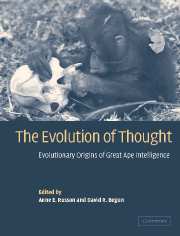Book contents
- Frontmatter
- Contents
- List of Contributors
- Preface
- 1 Evolutionary reconstructions of great ape intelligence
- 2 Enhanced cognitive capacity as a contingent fact of hominid phylogeny
- PART I COGNITION IN LIVING GREAT APES
- PART II MODERN GREAT APE ADAPTATION
- Introduction
- 7 What's in a brain? The question of a distinctive brain anatomy in great apes
- 8 Life histories and the evolution of large brain size in great apes
- 9 Evolution of complex feeding techniques in primates: is this the origin of great ape intelligence?
- 10 The special demands of great ape locomotion and posture
- 11 Great ape social systems
- 12 Diet and foraging of the great apes: ecological constraints on their social organizations and implications for their divergence
- PART III FOSSIL GREAT APE ADAPTATIONS
- Part IV INTEGRATION
- Author index
- Species index
- Subject index
7 - What's in a brain? The question of a distinctive brain anatomy in great apes
Published online by Cambridge University Press: 20 August 2009
- Frontmatter
- Contents
- List of Contributors
- Preface
- 1 Evolutionary reconstructions of great ape intelligence
- 2 Enhanced cognitive capacity as a contingent fact of hominid phylogeny
- PART I COGNITION IN LIVING GREAT APES
- PART II MODERN GREAT APE ADAPTATION
- Introduction
- 7 What's in a brain? The question of a distinctive brain anatomy in great apes
- 8 Life histories and the evolution of large brain size in great apes
- 9 Evolution of complex feeding techniques in primates: is this the origin of great ape intelligence?
- 10 The special demands of great ape locomotion and posture
- 11 Great ape social systems
- 12 Diet and foraging of the great apes: ecological constraints on their social organizations and implications for their divergence
- PART III FOSSIL GREAT APE ADAPTATIONS
- Part IV INTEGRATION
- Author index
- Species index
- Subject index
Summary
INTRODUCTION
Most scientists would not waste their time trying to teach sign language to a baboon or even a gibbon, but their success with the great apes is well known. The superior cognitive abilities of great apes are evident not only in their performance in such tasks as language learning, but also in their arithmetic, tool making and using, imitation, self-recognition, and feral skills indicative of a human-like intelligence. Although such skills do not represent the many dimensions of cognition and so cannot be generalized to all facets of intelligence, most researchers see a chasm with the great apes and humans on one side, and the lesser apes and monkeys on the other (see Tomasello & Call 1994 for another view). If this cognitive distinction is to be understood in terms of brain anatomy, then the neuroanatomy of the great apes should show more continuity with humans and less with the other anthropoids. Some headway has been made in discerning attributes of great ape anatomy that may parallel these cognitive patterns, but progress has been slow. This chapter will briefly discuss some of the more important findings in hominoid neuroanatomy that may have a bearing on our understanding of the great ape mind.
MEASURING THE BRAIN
Comparative studies are hindered by the rarity of ape brains and the time-consuming task of measuring the brain.
- Type
- Chapter
- Information
- The Evolution of ThoughtEvolutionary Origins of Great Ape Intelligence, pp. 105 - 121Publisher: Cambridge University PressPrint publication year: 2004
- 7
- Cited by



